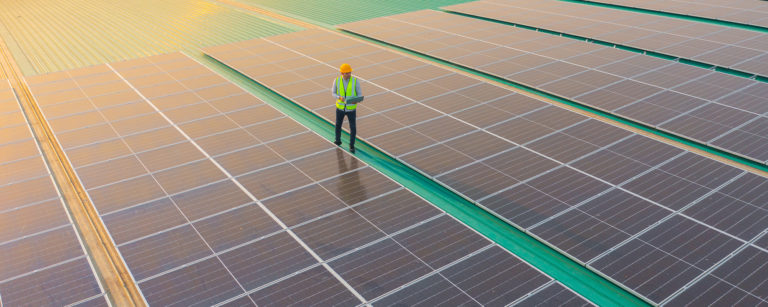Solar photovoltaic (PV) technology was first discovered by French physicist Edmond Becquerel in 1839. However, it wasn’t until the 1950s that the first silicon-based solar cells were proven. Today, solar power is one of the most popular renewable energy sources in the world, supplying 12% of global electricity in 2022. The largest countries, including China, the US, and Japan, are the biggest producers of solar energy.
With new developments promising to deliver more affordable, potent, and highly-efficient solar panels made from different materials that are thinner, lightweight, and transparent, it’s an exciting time for the solar industry. Discover our top innovative technologies in solar energy.
Solar tracking systems
Solar tracking systems use specific instruments to determine the location of the sun. An example of the most common applications for solar trackers are positioning photovoltaic panels; they maintain a perpendicular angle to the sun’s rays while setting up space telescopes to identify the sun’s direction.
The most common innovations in solar tracking systems focus on:
- Dual-axis tracking – enables more sunlight to be captured throughout the day by tracking the sun in both the horizontal and vertical planes.
- AI, IoT and machine learning – AI and machine learning algorithms enable prediction of the sun’s movement and adjustment of the angle of the solar panel. On top of that, IoT integration can give insights into real-time data on energy production and system performance.
- Wireless communication – wireless technology enables communication with other components of the solar energy system, including inverters and batteries.
- Lighter materials – researchers explore the result of using lighter materials in shaping and positioning the solar panels, without the need of using motors or mechanical components.
Thin-film solar cells
Thin-film solar cells are created by depositing one or more thin layers of photovoltaic material (also known as thin films or TFs) onto different materials and substrates. They are a lightweight and flexible alternative to traditional silicon solar panels.
Researchers from Massachusetts Institute of Technology (MIT) designed ultralight, flexible thin-film solar cells which weigh 100 times less than conventional solar panels and generate 18 times more power per kilogram (see the video below to find out more).
Recent advancements focus on flexible substrates, like metal foil or plastic which give more versatility. Types like perovskite solar cells that use a thin layer of perovskite material or tandem cells which allow for combining multiple layers of thin-film materials are some examples of new technologies in thin-film solar cells. Researchers are also exploring the use of spray-on solar cells suitable for wearables or portable devices.
Transparent solar cells
According to the World Economic Forum, the first fully transparent solar panels were developed in 2014 by Michigan State University (MSU). The transparent solar panels look like clear glass, meaning they are suitable for clear windows and even touch screens as they absorb only infrared and ultraviolet light.
Besides the main purpose of transparent solar panels which is for windows and other building materials, there are many possible uses for this technology, and it may eventually be incorporated into a range of goods, such as smartphones, tablets, and other electronic devices. Already, a new efficiency record for transparent solar cells has been established by researchers at the École Polytechnique Fédérale de Lausanne (EPFL) in Switzerland, paving the door for electricity-producing windows that could power our homes and devices.
Solar-powered desalination
On the international Earth Day we mentioned the scarcity of clean water in the world. Today we want to demonstrate a sustainable solution which can address the growing freshwater demand and boost water supplies. Solar-powered desalination is a technology that combines solar energy and water desalination to provide clean drinking water, potable water or sterilise medical tools in off-grid areas.
Recently, a research team at MIT and in China developed a desalination system that is more effective and less expensive than earlier sun desalination techniques in the process of finding a solution to the issue of salt accumulation. Without the need for a separate power source, the procedure may potentially be used to clean up tainted wastewater or create steam to sterilise medical equipment.
Solar-powered logistics
Solar-powered technology has also made significant advancements in agriculture and transportation sectors. For example, it can power agricultural irrigation systems, food processing equipment, and other farming machinery.
Furthermore, the usage of advanced equipment, such as solar-powered monitoring sensors can help track crucial parameters, like temperature, soil moisture or humidity levels, enabling farmers to optimise water usage and reduce waste. That way farmers can save money and energy while improving the environmental conditions of their farmland.
In transportation and logistics the use of solar energy can also help reduce carbon emissions. Solar power is already being applied to electric fleets for transportation goods, through rooftop installations on truck trailers or solar-powered trains that we mentioned here. On top of that, there are solar-powered GPS-based trackers that allow for measuring if the system runs efficiently without relying on the vehicle’s internal battery.












